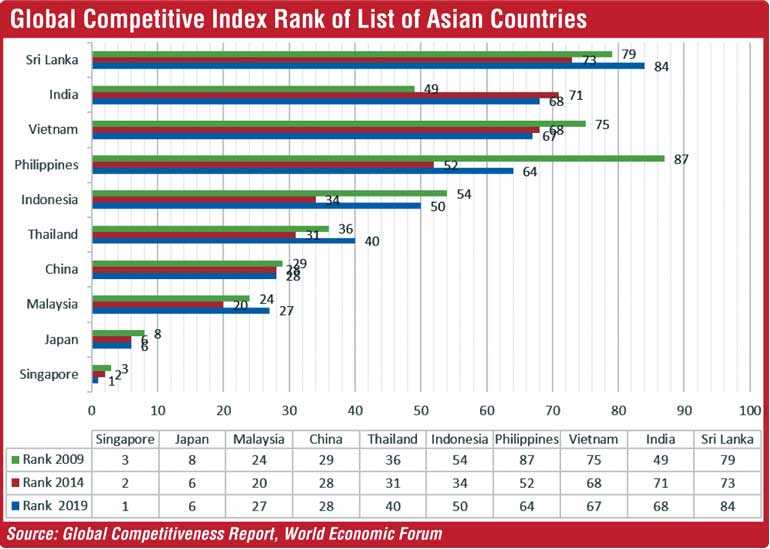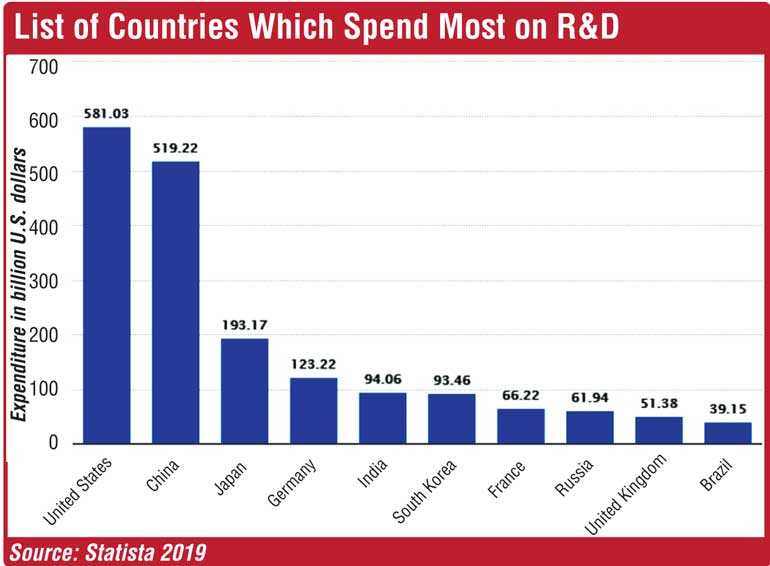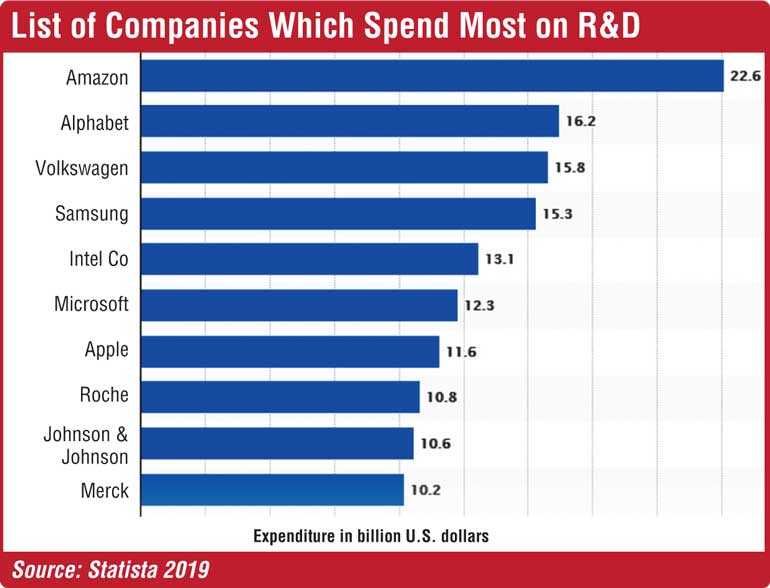Wednesday Dec 17, 2025
Wednesday Dec 17, 2025
Thursday, 23 January 2020 01:48 - - {{hitsCtrl.values.hits}}

Not long ago, on the day of our 71st Independence Day celebrations, the Army for the first time in our history paraded a locally built Multi-Barrel rocket launcher. It was never revealed that the Sri Lanka Army had an R&D wing named Center for Research and Development (CRD). News started coming in that they established it in 2006 and ran R&D since then. The results are excellent as per the live visuals on TV on that day. 
Why R&D?
What is research? And what is development? A layman would ask these questions to begin with. Follow-up questions would be: Does development really require research? Finally people may ask why develop? Why take such a hassle? Let’s copy and do something. The R&D story will end before it begins with this type of attitude. This is pretty similar to the Sri Lankan context which has resulted in lowly performance as a country.
What we need to understand is that the innovation through R&D is the major competitive advantage a country could have. According to an address by Dr. A.P.J Abdul Kalam to a gathering of tech students at Mahindra Ecole College in 2015, he claims that there are two sets of countries – developed countries and developing countries. The difference between these two are the competitiveness. Dr. Kalam takes the Global Competitiveness Index as an example. If we look at current rankings, Singapore is ranked one in the index.
Dr. Kalam in his address stresses the need for India to improve its rank in 2014 to reach the top 10 in next five years and states that growth competitiveness is determined by the innovative ability of an organisation. The innovation arises from initiatives taken by the institution and the R&D productivity of the firm, shaped by policies and nature of local institutions. Though India has not yet reached the position Dr. Kalam dreamt, they are slowly but steadily marching forward.
Research and development is the investigative process which results in new products, business processes, and innovations. R&D could come in two ways;
1. To solve a problem.
2. To have an edge on competition.
Be better and proving a point: Big nations
R&D has become a culture in many countries and it one of the key drivers in putting a country on to the development path and maintaining a sustainable economic growth. To remain competitive in many sectors countries have adopted R&D across many industries. The big nations have proven this, and evidence can be gathered just by looking at the number of new products/inventions that have come out over the last 20 years.
The world has already witnessed two world wars. World War II was fought with better weapons and equipment compared to World War I. A few examples are jet engine and radar. Dr. Hans von Ohain and Sir Frank Whittle share the credit of developing the jet engine independently. However, Ohain’s jet engine was the first to fly operationally. Dr. Ohain was a German. German’s strategically utilised aircrafts with jet engines to tackle superiority of allied forces. British were worried about increasing German threat in 1930s and started developing radar technology.
Developed nations always kept an eye on each other even after World War II. United States and Soviet Russia began the race to the space. on 12 April, 1961 Soviet cosmonaut Yuri Gagarin became the first man in space. However, undeterred Americans sent a man to the moon in 1969. It was all about proving a point, “Who is better or more powerful”.
But Japan was devastated after their humiliating defeat in World War II. They also wanted to prove a point. Industrial promotion measures were adopted by the Japanese Government after the war. One of them was especially, the R&D assistance. The entire world witnessed the vast development of Japan. They were the first industrialised nation in East Asia.
India is also no exception when it comes to proving a point. Exploring space is one of their many ambitions. Perhaps space must be the largest of them all. Their famous projects Chandrayaan 1, Chandrayaan 2, and Gaganyaan are evidence to their commitment.

Private investments in R&D: Corporate sector
In global context, Amazon, Alphabet, Samsung, Facebook, and Microsoft have been among the top ten spenders on R&D. Their success is more than visible. Their innovation has led the entire world to a different level which was not imagined by all of us in the last century. As a result, new industries, new professions, new business processes, and, even new business models emerged. These companies weigh heavily on R&D.
Sri Lankan dilemma
According to Sri Lanka Science, Technology & Innovation Statistical Handbook 2015 published in January 2018 Sri Lanka’s R&D expenditure is 0.11% of total GDP. As per the Global Competitive Index 2018, Sri Lanka ranks 110 from 119 countries based on the percentage of R&D expenditure against GDP.
We are even far below than our neighbours in the SAARC region. According to a study carried out by Mario Coccia in 2017, for countries to achieve higher relative productivity growth, their optimum R&D investments should be around 2.3-2.5% of GDP in the long run. In this light, we could see the highest investment was done by the government (59.6%) followed by corporate sector (34.4%).
The Sri Lankan situation of R&D seems to be at a very lower level. There may be isolated cases of successes. But statistics, as stated previously, prove that so much can be done by the country in order to be competitive globally. There are many institutions which have been established to promote R&D but the growth and commercialisation have failed significantly. Below three examples show the current situation in Sri Lanka.
1. Copying a concept or an idea from a local or foreign company.
2. Purchasing technology from foreign companies.
3. Adopting someone else’s business process.
Copying a concept or an idea from a local or foreign company
Usually we have seen companies copying from local or foreign businesses. If a product or a service introduced to the market, another company or two would always be there to copy the same. This happens in global context as well. Most of the local companies and businesses tend to go on the easier path. It even looks healthy for their budgets too. But what happens when others also copy the product.
Oversupply creates lower demand and alternatives would hit the market with technological developments. A company may or might enjoy short to medium term success. But what would happen to the same company in the long run. With so many competitors it would be very difficult to sustain the business in the long run. Outpacing competition is a must for longevity of a business.
Purchasing technology from foreign companies
It is widely accepted that adopting a technology in other words an off the shelf product, which has been proven and stable, ensures the prevention of a failure. Of course, you do not have to reinvent the wheel. It also gives the option of a quick buy. However, most of the times these purchases may be very expensive, and it may not provide the solutions which the clients require. Because it is a solution developed for another region or a jurisdiction.
Off-the-shelf technology will force a company to adjust its business model to suit the same which will result in losing the satisfaction of the clients. Losing satisfaction levels ultimately will lead to lower sales. In addition, with time the service providers increase their prices and if it’s a foreign company, payments should be made in US dollars or Euro, which exposes the company to an exchange rate risk too. Further, if it is a software, the upgrades will also cost a fortune. By the time company thinks of switching, the switching cost will be ultra-expensive and a nightmare.

Adopting someone else’s business process
Someone else’s business process might or may not work in the context of a local entity. But there are certain ground level realities one must take in to consideration when making a decision as critical as this. Because at the end of the day business process is a series of tasks that will push an entity to its intended business goals.
The culture, differences in client requirements of a specific industry or a geographic location, the change drivers of particular industry environment may be different to the other, and many more reasons could pave the way for an entity to see its bottom rather than going forward when adopting alien business processes.
The way forward
The world we know changes rapidly. The world we saw five years ago is not the world we live in now. In the next five years the same would occur. There seems to be a complacency in many industries in the country.
According to the statistics, there is a huge potential for the government as well as for the private sector to expand their R&D. Improving R&D could be the turning point to improve Sri Lanka’s global competitive ranking in order to be successful. At a time when the country is suffering from lack of foreign reserves it needs to look beyond traditional export income sources. As a country we have a long way to go even when compared with regional peers.
Creating an R&D eco-system is vital to improve R&D status when it comes to Sri Lankan context. There are few key features for a successful R&D eco-system;
Government support in cultivating policies and R&D culture
Policies, regulations, and incentives have to be in place to promote and develop the R&D eco-system. Government policy is the key. For an example, having a policy to set up an institution regionally to support and coordinate R&D would be the ideal launch pad. Alternatively, government could make a public private partnership to enhance R&D culture. Provision of different incentives such as taxes and loan schemes could be utilised in order to maintain support. However, institutional set up has to be as dynamic as in other competing countries.
Investment in human capital
R&D is mostly science and technology driven. Driving educational sector towards Science and Technology and supporting the same with management, sales, finance, and entrepreneurship courses would bring about expected outcome.
Collaborating science with entrepreneurship
Commercialising is critical to succeed in R&D. There is no point in creating a new product or a service if it cannot be commercialised. Therefore, it is important that a mechanism in place for the local universities and technological institutes to closely work with private sector to commercialise the efforts.
Private sector commitment
Traditionally private sector has been termed as the ‘Engine of Growth’. In this scenario private sector could be the catalyst of change. They can contribute more towards R&D. According to the statistics private sector has contribution to R&D is only 34.4%. There is a huge potential to increase that number.
Easy availability of capital
Funding is always the issue. There must be multiple sources of capital. Commercially focused equity investment platform such as a stock market is ideal for a company to raise capital. Crowdfunding platforms can be an alternative for a startup. Development banking is also another alternative when it comes to industrial growth through R&D.
Startup culture
Startups emanate from disruptive product development. They provide solutions to problems that no one has taken any action before. Creating a startup culture will eventually lead to improvement of R&D. There are some startup incubators currently in Sri Lanka to support startups. However, more work needs to be done in order to achieve the expected outcome.
[The writer is a holder of B.Sc in Business Administration (Business Economics) Special degree and an MBA from Cardiff Metropolitan University in UK. He counts 13 years’ working experience in the corporate sector. Writer can be reached at [email protected].]